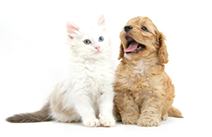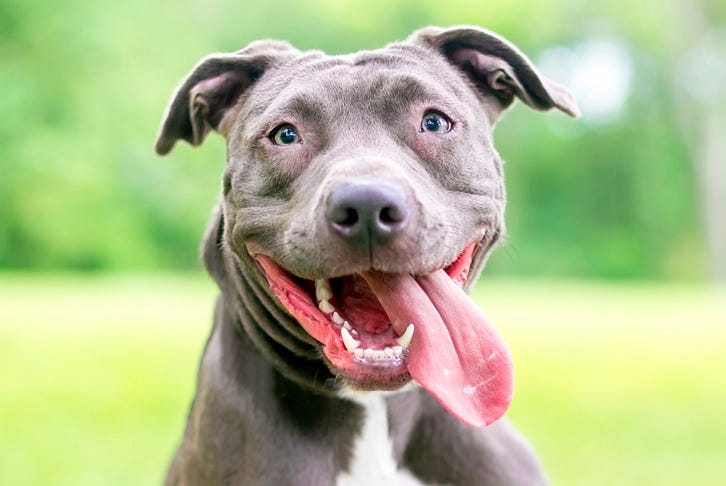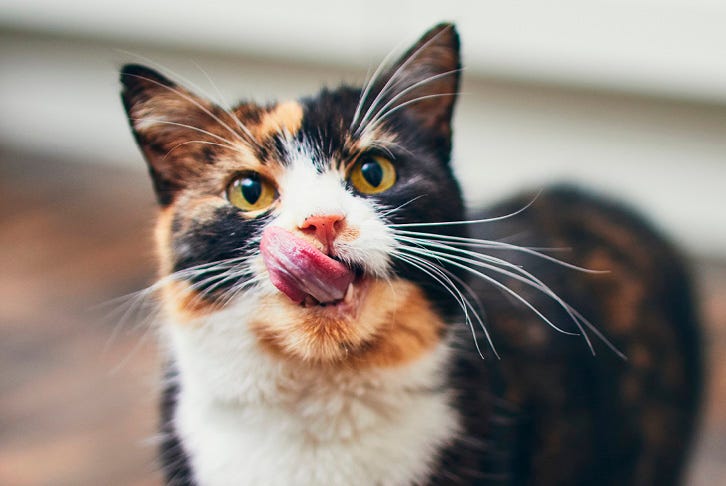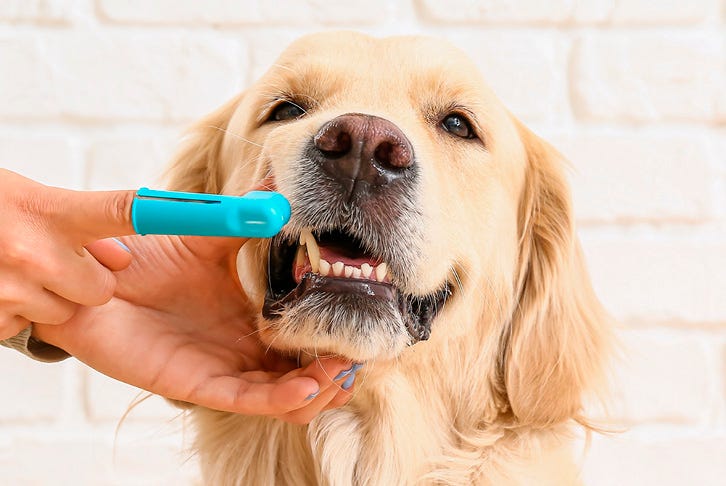Dental disease in cats and dogs
When it comes to your pet's dental health, prevention is always the best treatment. However, identifying where there might be a dental health condition is often near impossible, with many pets showing no obvious symptoms at all.
While it may be hard to identify, 80% of dogs and cats over three years of age have some form of dental disease.*
Bad Breath
While diet will affect your pet's breath they should never have a strong foul odour. This may be a sign of infection, decay or even rotting food stuck between their teeth. If your pet has overly smelly breath, book an appointment with your local Animates Vetcare team for a dental check-up.
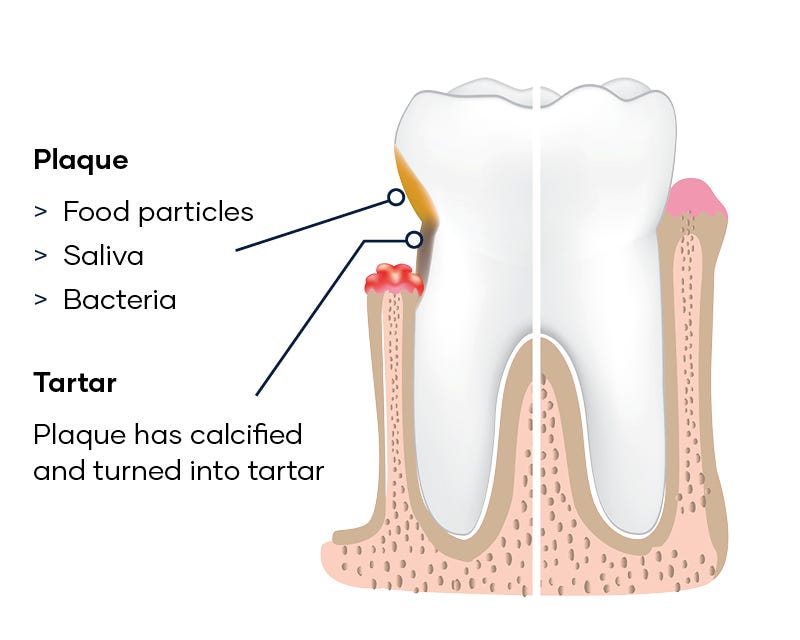
What causes dental disease?
Dental disease is inflammation of the teeth and gums caused by the build-up of plaque and tartar. Plaque is made up of food particles, saliva and bacteria, which sticks to the surface of the tooth and if not removed will calcify into tartar and progress from there. This takes place above and below the gum line and over time can lead to the destruction of the supporting tissue of the teeth including bone, resulting in bad breath, oral pain and loss of teeth.
Dental disease is very common and is the leading cause of early tooth loss in cats and dogs. Left untreated, dental disease advances and can contribute to heart, liver and kidney problems.
The good news is, regular dental checks and care can help your pet's dental health and save you money in the long-run.
Grades of dental disease
Dental disease is insidious and progressive. As our pets age and the disease progresses it becomes harder and more costly to treat.
Grade 0
No plaque or gingivitis are present. Young, healthy dogs and cats between 6 and 12 months of age are often grade 0.
Grade 1
Mild gingivitis and plaque are present. A grade 1 condition is often reversible with brushing and appropriate chewing.
Grade 2
Mild to moderate tartar (mineralized plaque and bacteria) and gingivitis are present on multiple teeth. Gingivitis is usually reversible after professional scaling and polishing.
Grade 3
Heavy tartar and periodontal (gum) disease with bone loss are present. With grade 3 patients, oral pain is likely. Tooth lesions and fractures may be present under tartar and without intervention may be irreversible.
Grade 4
Severe tartar, periodontal disease, and oral pain are present. With grade 4 patients, tooth loss is imminent.

What are the signs of dental disease?
There are a number of signs that can alert you to the possibility that your pet is living with dental disease.
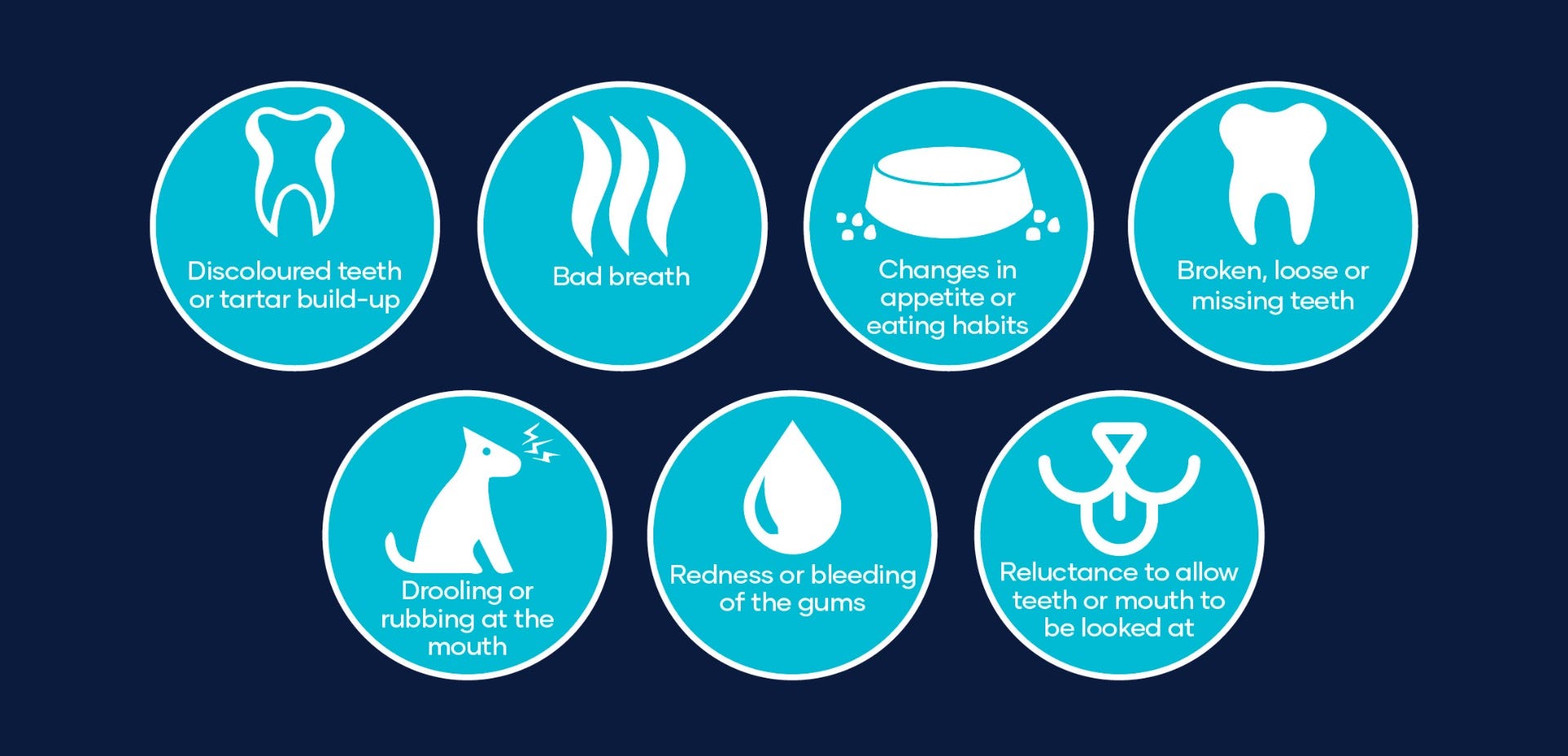
If you answer yes to any of the above signs, your pet may be in need of a dental health check. If they aren’t showing any of the above symptoms, ask your local Animates Vetcare team to check their teeth at their next routine check-up.
To keep your pet's teeth healthy, check out some of the below tips and tricks. Remember, pets need their teeth cleaned and maintained just like humans.
Tips to Prevent Dental Disease
- Dental treats come in a range of textures and flavours to help fight tartar and plaque build up and freshen breath.
- Certain dental chew toys have various shapes and grooves that make it easy to get into your pet's mouth and assist in oral health.
- Brushing teeth isn’t just important for us humans and should be just as frequent in our fur-friends. Ensure you use pet specific toothpaste, as human toothpaste is harmful for pets.
- Regularly check your pet’s gums - they should look pink and healthy rather than red and swollen. Regularly massage your pet’s gums to help keep them healthy and avoid tooth decay.
- Vet prescription dental diets are a great way to combat tartar and help prevent dental disease. With larger sized kibble your pet will need to chew harder which helps to break away tartar build up on teeth.
- Ensure your pet eats slowly as this will allow the kibble to make contact with the teeth to break down tartar.
- Small pets such as rabbits and guinea pigs are at risk of their teeth overgrowing. Including coarse foods such as grass, hay, herbs and carrots in their diet will encourage chewing and naturally grind their teeth preventing overgrowth.
- Check their teeth regularly, feeling for lumps or abscesses under the neck and on the sides of the jawline.
- Regular check-ups (we recommend every six months), at your local Animates Vetcare or your local veterinarian is also important to help identify if your pet's teeth may need a little more attention with a scale and polish.
Small pets, cats and dogs use their teeth and jaws to grind and swallow food, teeth which are in poor condition can cause pain and discomfort as well as causing problems for their organs such as the heart, lungs and kidneys.
Tips & Tricks for Teeth Brushing
You can start brushing your pet’s teeth from eight weeks old, which is a great age for familiarising them with a daily dental routine.
- Start slowly, giving plenty of affection and praise. Create routine by brushing at the same time. If they are food motivated brush their teeth just before dinner and use it as the reward.
- Get your pet used to the sensation of touch on their lips, teeth and gums using your finger. Try putting a few drops of chicken/beef stock or tuna juice (cats) on your finger; they will begin to look forward to the ‘reward’ associated with this touch. Note: small pets may feel more relaxed sitting on your knee.
- Repeat this touch with a piece of flavoured (stock or tuna) cloth wrapped around your finger or a cotton wool bud. Start along their gum lines before lightly massaging their teeth and gums.
- Introduce the toothbrush and dip the toothbrush in the same flavour before holding it at a 45 degree angle to the tooth and gently brushing back and forth in a circular motion. Begin slowly with one or two strokes at the front of their mouth before continuing to their back teeth and if possible their tongue.
- Now you can introduce the toothpaste, rub a small amount of toothpaste onto their rubber chew toys and encourage them to play and chew.
- Combine for the ultimate clean; it is now time to use both the toothbrush and paste together. Remember to start slowly and build up to at least 30 – 60 seconds on each side, sticking to a daily routine as much as possible. Note: as losing their baby teeth can be painful it is recommended that you stop teeth brushing until their permanent teeth come in.
- Treat your pet - after you have finished brushing their teeth create a positive association by giving your pet a small treat and of course a big cuddle.
Dental Hygiene Tools
- Pet specific toothbrush.
- Pet specific toothpaste - human toothpaste is harmful to pets if swallowed.
- Oral rinses and gels. These must be pet specific, ask us for guidance.
- A vet prescription dental diet that is designed to help clean their teeth.
- Rubber chew toys.
- Dental treats that can help reduce tartar build up.
How can I help my pet have a healthy mouth?
Regular health checks will help to identify any development of dental disease and will allow your veterinarian to discuss the best management plan for your pet. For adult cats and dogs with existing dental disease, a dental treatment to remove plaque and tartar from under the gum line is often necessary to get their mouth back into top condition. This will allow us to start preventative measures with a clean mouth and prevent, or slow down, dental disease developing again in the future.
There are things you can do at home such as introducing vet prescription diets, in particular dental diets that can significantly reduce the development of tartar. Some chewy treats are also specifically designed to reduce tartar, promote healthy gums and freshen breath. For best results, look out for the VOHC (Veterinary Oral Health Council) approval on products.
If your pet is calm and relaxed, daily brushing of their teeth with a specially designed pet toothbrush and toothpaste is also very beneficial.
For more information about how to keep your pet’s teeth healthy talk to your local Animates Vetcare team.
*Based on Australian research and applies to pets over the age of 3 years.
While many people believe that bad breath is normal for their furry friends, it can be an indication of a deeper problem. Dental disease, or periodontal disease, is inflammation of the gums caused by a build-up of plaque.
Although diet can affect your pet's breath, they should never have a strong foul odour. This may be a sign of infection, decay or even rotting food stuck between their teeth. If your pet has overly smelly breath, book an appointment with your local Animates Vetcare team for a dental check-up.
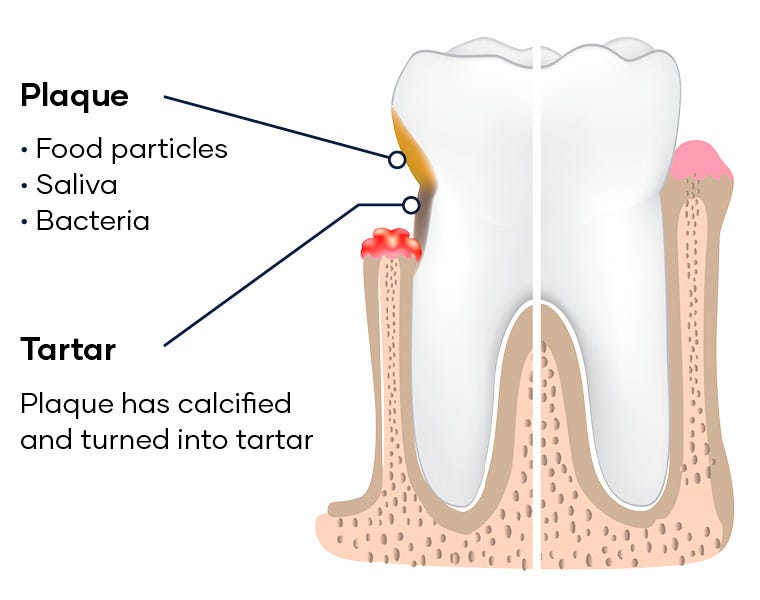 What causes dental disease?
What causes dental disease?
Dental disease is inflammation of the teeth and gums caused by the build-up of plaque and tartar. Plaque is made up of food particles, saliva and bacteria, which sticks to the surface of the tooth and if not removed will calcify into tartar and progress from there. This takes place above and below the gum line and over time can lead to the destruction of the supporting tissue of the teeth including bone, resulting in bad breath, oral pain and loss of teeth.
Dental disease is very common and is the leading cause of early tooth loss in cats and dogs. Left untreated, dental disease advances and can contribute to heart, liver and kidney problems.
The good news is, regular dental checks and care can help your pet's dental health and save you money in the long-run.
Grades of dental disease
Dental disease is insidious and progressive. As our pets age and the disease progresses it becomes harder and more costly to treat.
Grade 0
No plaque or gingivitis are present. Young, healthy dogs and cats between 6 and 12 months of age are often grade 0.
Grade 1
Mild gingivitis and plaque are present. A grade 1 condition is often reversible with brushing and appropriate chewing.
Grade 2
Mild to moderate tartar (mineralized plaque and bacteria) and gingivitis are present on multiple teeth. Gingivitis is usually reversible after professional scaling and polishing.
Grade 3
Heavy tartar and periodontal (gum) disease with bone loss are present. With grade 3 patients, oral pain is likely. Tooth lesions and fractures may be present under tartar and without intervention may be irreversible.
Grade 4
Severe tartar, periodontal disease, and oral pain are present. With grade 4 patients, tooth loss is imminent.

What are the signs of dental disease?
There are a number of signs that can alert you to the possibility that your pet is living with dental disease.

If you answer yes to any of the above signs, your pet may be in need of a dental health check. If they aren’t showing any of the above symptoms, ask your local Animates Vetcare team to check their teeth at their next routine check-up.
To keep your pet's teeth healthy, check out some of the below tips and tricks. Remember, pets need their teeth cleaned and maintained just like humans.
Tips to Prevent Dental Disease
- Dental treats come in a range of textures and flavours to help fight tartar and plaque build up and freshen breath.
- Certain dental chew toys have various shapes and grooves that make it easy to get into your pet's mouth and assist in oral health.
- Brushing teeth isn’t just important for us humans and should be just as frequent in our fur-friends. Ensure you use pet specific toothpaste, as human toothpaste is harmful for pets.
- Regularly check your pet’s gums - they should look pink and healthy rather than red and swollen. Regularly massage your pet’s gums to help keep them healthy and avoid tooth decay.
- Vet prescription dental diets are a great way to combat tartar and help prevent dental disease. With larger sized kibble your pet will need to chew harder which helps to break away tartar build up on teeth.
- Ensure your pet eats slowly as this will allow the kibble to make contact with the teeth to break down tartar.
- Small pets such as rabbits and guinea pigs are at risk of their teeth overgrowing. Including coarse foods such as grass, hay, herbs and carrots in their diet will encourage chewing and naturally grind their teeth preventing overgrowth.
- Check their teeth regularly, feeling for lumps or abscesses under the neck and on the sides of the jawline.
- Regular check-ups (we recommend every six months), at your local Animates Vetcare or your local veterinarian is also important to help identify if your pet's teeth may need a little more attention with a scale and polish.
- Small pets, cats and dogs use their teeth and jaws to grind and swallow food, teeth which are in poor condition can cause pain and discomfort as well as causing problems for their organs such as the heart, lungs and kidneys.
Tips & Tricks for Teeth Brushing
- You can start brushing your pet’s teeth from eight weeks old, which is a great age for familiarising them with a daily dental routine.
- We have compiled a handy guide to get you started.
- Start slowly, giving plenty of affection and praise. Create routine by brushing at the same time. If they are food motivated brush their teeth just before dinner and use it as the reward.
- Get your pet used to the sensation of touch on their lips, teeth and gums using your finger. Try putting a few drops of chicken/beef stock or tuna juice (cats) on your finger; they will begin to look forward to the ‘reward’ associated with this touch. Note: small pets may feel more relaxed sitting on your knee.
- Repeat this touch with a piece of flavoured (stock or tuna) cloth wrapped around your finger or a cotton wool bud. Start along their gum lines before lightly massaging their teeth and gums.
- Introduce the toothbrush and dip the toothbrush in the same flavour before holding it at a 45 degree angle to the tooth and gently brushing back and forth in a circular motion. Begin slowly with one or two strokes at the front of their mouth before continuing to their back teeth and if possible their tongue.
- Now you can introduce the toothpaste, rub a small amount of toothpaste onto their rubber chew toys and encourage them to play and chew.
- Combine for the ultimate clean; it is now time to use both the toothbrush and paste together. Remember to start slowly and build up to at least 30 – 60 seconds on each side, sticking to a daily routine as much as possible. Note: as losing their baby teeth can be painful it is recommended that you stop teeth brushing until their permanent teeth come in.
- Treat your pet - after you have finished brushing their teeth create a positive association by giving your pet a small treat and of course a big cuddle.
Dental Hygiene Tools
- Pet specific toothbrush.
- Pet specific toothpaste - human toothpaste is harmful to pets if swallowed.
- Oral rinses and gels. These must be pet specific, ask us for guidance.
- A vet prescription dental diet that is designed to help clean their teeth.
- Rubber chew toys.
- Dental treats that can help reduce tartar build up.
How can I help my pet have a healthy mouth?
Regular health checks will help to identify any development of dental disease and will allow your veterinarian to discuss the best management plan for your pet. For adult cats and dogs with existing dental disease, a dental treatment to remove plaque and tartar from under the gum line is often necessary to get their mouth back into top condition. This will allow us to start preventative measures with a clean mouth and prevent, or slow down, dental disease developing again in the future.
There are things you can do at home such as introducing vet prescription diets, in particular dental diets that can significantly reduce the development of tartar. Some chewy treats are also specifically designed to reduce tartar, promote healthy gums and freshen breath. For best results, look out for the VOHC (Veterinary Oral Health Council) approval on products.
If your pet is calm and relaxed, daily brushing of their teeth with a specially designed pet toothbrush and toothpaste is also very beneficial.
For more information about how to keep your pet’s teeth healthy talk to your local Animates Vetcare team.
*Based on Australian research and applies to pets over the age of 3 years.


